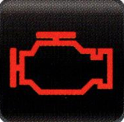
Check Engine Light
This is one of the more difficult lights to locate the issue of. This is connected to sensors all over the vehicle. It includes the engine, fuel, and emissions systems as well. When the light illuminates, it could mean one of several things. First, check the gas cap. Most vehicles have a pressurized fuel system and vapor recovery loop. If you do not twist the gas cap until it clicks, the fuel system is not sealed. This will not allow it to pressurize correctly. It will then result in the light coming on. If you check the gas cap and the light still stays on, bring the vehicle in as soon as you can so we can inspect the issue for you.
Service Vehicle Soon
The service engine light may come on if you have lighting or other electrical issues. Check all the lights. This should include the head lights, brake lights, and turn signals. Sometimes this light will also come on if there is a traction issue with your vehicle.
Battery Warning Light
This light looks like a picture of a battery. It can indicate that the voltage level is below the normal level. This results in the vehicle’s charging system not functioning properly. Make sure that the battery is inspected. This also should include the terminals of the battery, alternator belt, and overall condition of it as well.
Brake Warning Light
When the brake warning light comes on, it is an indication that there is something wrong with the braking system. Check to make sure the parking brake is not on. The light could also mean the brake fluid is low. An ABS issue could also be the reason the light is illuminating.
Coolant Warning Light
This light helps to indicate the level of coolant currently in the vehicle. It can also mean that the temperature has exceeded the normal limits. Check the coolant level, radiator cap, and for any sign of a leak if you see this come on. Always make sure to have the vehicle off for several minutes before removing the radiator cap.




Recent Comments